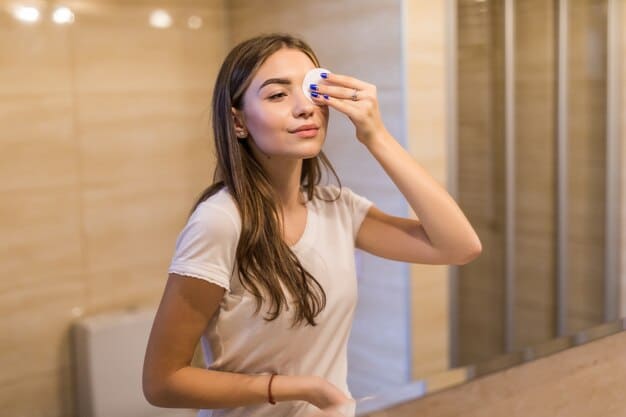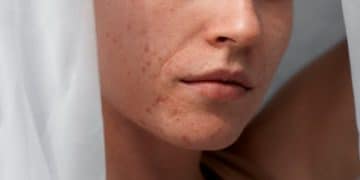How to Get Rid of Dark Circles Under Your Eyes: A Guide

Anúncios
Achieving a brighter, more refreshed look often involves understanding how to get rid of dark circles under your eyes by addressing underlying causes and applying targeted treatments, from lifestyle changes to advanced cosmetic procedures.
Living with dark circles under your eyes can be a persistent cosmetic concern, often leaving one looking tired, even after a full night’s sleep. Understanding how to get rid of dark circles under your eyes involves delving into their diverse origins and exploring comprehensive strategies, ranging from simple home remedies to advanced dermatological solutions, all aimed at restoring a more vibrant and youthful appearance.
Understanding the Roots of Dark Circles
Dark circles are a common complaint, but their appearance can stem from a variety of factors. Simply put, they are not always just a sign of fatigue. Unraveling the specific cause is crucial for determining the most effective course of action and truly understanding how to get rid of dark circles under your eyes.
Several physiological elements contribute to under-eye discoloration, and understanding these can help in tailoring effective treatments. Genetics, for instance, play a significant role; some individuals are predisposed to thinner skin or more prominent blood vessels under their eyes due to inherited traits.
Common Causes: Beyond Lack of Sleep
While sleep deprivation is a well-known culprit, many other factors contribute to the problem. These can range from simple lifestyle habits to more complex medical conditions.
- Genetics: A family history of dark circles suggests a genetic predisposition.
- Thinning Skin: As we age, the skin under our eyes thins, making blood vessels more visible.
- Dehydration: Inadequate water intake can make the skin appear dull and sunken.
- Allergies: Allergic reactions can cause blood vessels to dilate, leading to discoloration.
Another often overlooked cause is prolonged sun exposure. UV radiation can stimulate melanin production, leading to hyperpigmentation in the delicate under-eye area. This is why sun protection is paramount, not just for general skin health, but specifically when considering how to get rid of dark circles under your eyes.
Nutritional deficiencies, particularly an iron deficiency leading to anemia, can also manifest as dark circles due to reduced oxygen delivery to tissues. Ensuring a balanced diet rich in essential vitamins and minerals is not just good for overall health but also contributes to healthy-looking skin around the eyes.
Therefore, while getting enough rest is essential, a holistic approach that considers genetics, skin health, hydration, and nutritional intake is often necessary to effectively address and minimize the appearance of these persistent shadows.
Lifestyle Adjustments for Brighter Eyes
Before considering more intensive treatments, making certain lifestyle adjustments can significantly improve the appearance of dark circles. These changes are foundational steps in learning how to get rid of dark circles under your eyes and often yield noticeable results over time.
The cumulative effect of daily habits often dictates the health and appearance of our skin, especially the delicate under-eye area. Small, consistent changes can lead to substantial improvements.
Prioritize Quality Sleep
Poor sleep quality or quantity can lead to blood vessels dilating, making dark circles more apparent. Aim for 7-9 hours of uninterrupted sleep each night.
- Consistent Sleep Schedule: Go to bed and wake up at the same time daily, even on weekends.
- Elevate Your Head: Sleeping with your head slightly elevated can prevent fluid pooling under the eyes.
- Optimize Sleep Environment: Ensure your bedroom is dark, quiet, and cool for optimal rest.
The position in which you sleep can also influence fluid retention. Sleeping flat can sometimes encourage fluid to accumulate, making puffiness and dark circles more pronounced. Using an extra pillow to slightly elevate your head can help counteract this effect.
Hydration and Diet Matter
Dehydration can make the skin dull and dry, emphasizing underlying blood vessels. Adequate water intake is essential for skin elasticity and overall health. Furthermore, a diet rich in antioxidants and vitamins can support skin health.
Consuming foods rich in Vitamin K, C, and E can strengthen capillary walls and reduce hyperpigmentation. Think leafy greens, berries, citrus fruits, and nuts. Limiting sodium intake can also help prevent fluid retention that contributes to under-eye bags, impacting efforts on how to get rid of dark circles under your eyes.
Reducing alcohol consumption and quitting smoking are also critical steps. Alcohol can dehydrate the body and cause blood vessels to dilate, while smoking accelerates skin aging and can worsen discoloration due to nicotine’s effects on circulation.
By consciously incorporating these habits into your daily routine, you’re not only addressing the symptoms of dark circles but also fostering overall well-being, which naturally reflects in healthier, brighter skin around the eyes.
Topical Treatments and Skincare Regimens

Once lifestyle changes are optimized, incorporating targeted topical treatments into your daily skincare routine can significantly help in learning how to get rid of dark circles under your eyes. The skin around the eyes is exceptionally delicate, making product selection crucial.
The right combination of active ingredients can address various aspects of dark circles, from hyperpigmentation to vascular issues and skin thinning. Consistency is key when it comes to seeing results from topical applications.
Key Ingredients to Look For
When selecting eye creams and serums, certain ingredients stand out for their proven efficacy in treating dark circles. These ingredients work by targeting different aspects of the problem.
- Vitamin C: A powerful antioxidant that brightens skin and stimulates collagen production.
- Retinol: Encourages cell turnover and boosts collagen, thickening the skin over time.
- Hyaluronic Acid: Provides intense hydration, plumping the skin and reducing the appearance of shadows.
- Niacinamide: Reduces inflammation and improves skin barrier function, often used for pigmentation.
- Caffeine: Temporarily constricts blood vessels, reducing puffiness and dark shadows caused by vascular issues.
Beyond these, look for ingredients like green tea extract, arnica, and peptides. Green tea contains polyphenols that offer antioxidant and anti-inflammatory benefits, while arnica is traditionally used to reduce bruising and inflammation. Peptides can signal the skin to produce more collagen, improving firmness and elasticity.
Proper Application Techniques
The way you apply products is almost as important as the products themselves. The skin around the eyes is fragile and easily damaged by vigorous rubbing.
Always use your ring finger, which typically applies the least pressure. Dab the product gently along the orbital bone, moving from the inner corner outwards. Avoid pulling or stretching the skin. Apply products to clean, dry skin, typically after cleansing and toning, and before heavier moisturizers.
Remember that some active ingredients, like retinol, can increase sun sensitivity, so it’s vital to pair their use with daily broad-spectrum SPF to protect the delicate eye area from further pigmentation and aging. This comprehensive approach to topical treatments is a significant step in understanding how to get rid of dark circles under your eyes effectively.
Professional Treatments and Procedures
For those seeking more dramatic or faster results, or when lifestyle changes and topical treatments aren’t sufficient, professional aesthetic procedures offer advanced solutions to how to get rid of dark circles under your eyes. These treatments are typically performed by dermatologists or licensed aesthetic practitioners.
It’s crucial to consult with a qualified professional to determine the most appropriate treatment based on the underlying cause of your dark circles, as well as your skin type and overall health. A thorough assessment can prevent adverse effects and ensure optimal outcomes.
Dermal Fillers for Tear Trough Deformity
One common cause of dark circles is the loss of volume in the tear trough area, creating a hollow that casts a shadow. Hyaluronic acid dermal fillers are an effective solution to plump up this area, reducing the appearance of shadows.
- Immediate Results: Patients often see improvement right after the procedure.
- Temporary: Effects typically last from 6 months to 1.5 years, requiring touch-ups.
- Minimally Invasive: A quick office procedure with minimal downtime.
The key to successful filler treatment is precise placement by an experienced injector to avoid complications like lumpiness or a bluish tint (Tyndall effect). It’s an art as much as it is a science.
Laser Therapy for Pigmentation and Vascularity
Laser treatments can target both hyperpigmentation and prominent blood vessels responsible for dark circles. Different types of lasers are used depending on the specific cause.
Pulsed Dye Lasers (PDL) are effective for vascular dark circles by targeting hemoglobin in blood vessels. For pigmentation, Q-switched or picosecond lasers break down excess melanin. These treatments require multiple sessions and some downtime, but can yield significant improvements.
It’s important to protect the treated area from sun exposure post-laser therapy to prevent reverse pigmentation and ensure the longevity of the results. Your dermatologist will provide specific aftercare instructions tailored to your skin and the type of laser used.
Chemical Peels for Surface Discoloration
Gentle chemical peels, particularly those containing alpha hydroxy acids (AHAs) or trichloroacetic acid (TCA) at low concentrations, can exfoliate the top layer of skin, helping to reduce superficial pigmentation and improve skin texture around the eyes.
These peels must be specifically formulated for the delicate eye area and applied by a professional to avoid irritation or complications. They work by encouraging cell turnover, revealing fresher, brighter skin underneath.
While professional treatments offer advanced options, they often complement, rather than replace, good lifestyle habits and a consistent skincare routine. A multi-faceted approach often provides the best and most sustainable results when tackling how to get rid of dark circles under your eyes.
Holistic Approaches and Home Remedies
While medical treatments and high-tech skincare products offer significant solutions, many people still turn to holistic approaches and time-tested home remedies for daily support in understanding how to get rid of dark circles under your eyes. These methods are generally safe, cost-effective, and can be easily integrated into your routine.
These natural remedies often work by reducing inflammation, providing hydration, or offering gentle constriction to blood vessels, which can temporarily diminish the appearance of dark circles. They complement more intensive treatments and are excellent for ongoing maintenance.
Cool Compresses and Massage
Applying a cool compress can constrict blood vessels and reduce puffiness. This is particularly effective for dark circles caused by vascular congestion or fluid retention.
- Cucumber Slices: Their high water content and antioxidants provide a soothing, cooling effect.
- Chilled Teabags: Green tea and black tea contain caffeine and antioxidants that can temporarily shrink blood vessels. Use them chilled and damp.
- Cold Spoons: Place two spoons in the refrigerator for 10-15 minutes, then press the curved side against your under-eye area for instant relief.
Gentle massage can also improve circulation and lymphatic drainage, helping to move pooled fluids away from the eye area. Using a jade roller or your ring finger, lightly tap or roll from the inner corner of your eye towards your temples.
Natural Ingredient Masks
Several pantry staples can be transformed into effective, natural eye masks to brighten and soothe the under-eye area. Always perform a patch test first to ensure no allergic reactions.
Aloe Vera: Known for its soothing and hydrating properties, fresh aloe vera gel can be gently applied to moisturize and calm the skin. Its anti-inflammatory benefits can reduce irritation that contributes to dark circles.
Almond Oil: Rich in Vitamin E, almond oil is an emollient that can help moisturize and nourish the delicate skin. Gently massage a few drops before bedtime to improve skin texture and reduce dryness.
Potato Slices or Juice: Potatoes contain catecholase, an enzyme that has skin-lightening properties. Grate a potato, squeeze out the juice, and apply it with a cotton ball, or simply place thin slices over your eyes for 15-20 minutes.
While these remedies are generally safe for most people, results vary and are typically temporary. They are best used as part of a consistent daily routine alongside good skincare and lifestyle habits, offering a gentle, natural approach to how to get rid of dark circles under your eyes.
Makeup Techniques for Concealment
While addressing the root causes and applying treatments is vital for long-term improvement, makeup offers an immediate and effective way to conceal dark circles. Knowing the right techniques and products can significantly enhance your appearance and boost confidence, bridging the gap while treatments take effect or for special occasions. Effective concealment is an art, and mastering it helps in understanding how to get rid of dark circles under your eyes for instant perfection.
The goal isn’t just to cover, but to neutralize and brighten, ensuring the under-eye area looks natural and smooth, not caked or grey. The right shade and consistency are paramount.
Choosing the Right Concealer Shade
Selecting the correct shade is the most crucial step. A common mistake is to use a concealer that is too light, which can create a reverse raccoon effect or make the area look greyish.
- Color Correction First: For very dark, purplish, or bluish circles, a peach or orange-toned color corrector applied sparingly underneath your regular concealer can neutralize the discoloration.
- One Shade Lighter: Choose a concealer that is one shade lighter than your natural skin tone or foundation. This brightens the area without looking unnatural.
- Undertone Matching: If your skin has yellow undertones, a concealer with a slightly peachy or golden hue can be flattering. For pinker undertones, a more neutral or slightly yellow-based concealer might work better.
Consider the undertone of your dark circles themselves. Blue or purple circles benefit from peach or orange correctors, while brown or grey circles might require a more yellow or even green corrector, depending on the specific hue.
Application Tips for Flawless Coverage
Once you have the right products, proper application ensures a seamless, long-lasting finish that effectively conceals without creasing.
Prep the Skin: Hydrate the under-eye area with a lightweight eye cream before applying any makeup. This smooths out fine lines and prevents concealer from settling into creases, making it easier to blend.
Dot and Blend: Apply a small amount of product (corrector first, then concealer) in dots or light strokes only on the darkest areas. Use a damp beauty sponge, your ring finger, or a small, fluffy brush to gently pat and blend the product into the skin. Avoid rubbing, as this can move the product and irritate the delicate skin.
Set with Powder: To prevent creasing and ensure longevity, lightly set the concealer with a translucent setting powder. Use a small, fluffy brush and sparingly apply to avoid a heavy, cakey look. “Baking” with powder can offer more intense setting but should be used cautiously on very dry or mature skin.
Avoid Over-Application: Less is often more. Layering too much product can lead to creasing and accentuating fine lines rather than concealing dark circles. Build coverage gradually as needed.
By combining strategic product selection with precise application techniques, makeup becomes a powerful tool in your strategy for how to get rid of dark circles under your eyes, giving you immediate visible improvement while other treatments work their magic.
Preventative Measures and Long-Term Care

Preventing dark circles from appearing or worsening is just as important as treating existing ones. Long-term care involves adopting habits that protect the delicate under-eye skin and promote overall health. This proactive approach is fundamental to truly mastering how to get rid of dark circles under your eyes permanently.
Consistent preventative measures are often the most impactful in maintaining youthful, bright eyes. They address the underlying predispositions before they manifest as visible dark circles.
Sun Protection is Non-Negotiable
UV radiation is a significant contributor to hyperpigmentation and accelerates skin aging, making blood vessels more prominent. Protecting the under-eye area from the sun is paramount.
- Daily SPF: Apply a broad-spectrum sunscreen with at least SPF 30 every day, even on cloudy days. Ensure it’s safe for use around the eyes.
- Wear Sunglasses: Choose sunglasses that offer 100% UV protection and are large enough to shield the entire eye area effectively.
- Wide-Brimmed Hats: Add a physical barrier against the sun’s rays, especially during peak hours.
Sun protection isn’t solely about preventing sunburn; it’s about safeguarding collagen and elastin, preventing premature signs of aging, and mitigating the overproduction of melanin that leads to dark spots and hyperpigmentation around the eyes.
Manage Allergies and Skin Sensitivity
Chronic rubbing due to allergies or irritation can damage capillaries and cause post-inflammatory hyperpigmentation. Identifying and managing allergens is crucial.
If you suffer from seasonal allergies, consult with a doctor about antihistamines or other allergy management strategies. Avoid harsh rubbing of the eyes, and use gentle, hypoallergenic skincare products specifically designed for sensitive skin, particularly around the eye area. Pat, don’t rub, your eyes when cleansing or applying products.
Balanced Lifestyle for Eye Health
A holistic approach to health directly impacts the appearance of your eyes. Stress, poor nutrition, and lack of exercise can all contribute to tired-looking skin and dark circles.
Stress Reduction: Chronic stress can disrupt sleep patterns and lead to inflammation. Incorporate stress-reducing activities like meditation, yoga, or spending time in nature.
Nutrient-Rich Diet: Ensure your diet includes plenty of fruits, vegetables, and whole grains. Vitamins C, E, and K, along with iron and antioxidants, are vital for skin health and circulation.
Regular Exercise: Improves blood circulation, delivering oxygen and nutrients efficiently to skin cells and helping to flush out toxins.
By integrating these preventative measures and committing to long-term eye care, you can significantly reduce the likelihood and severity of dark circles, ensuring a continually refreshed and vibrant appearance. These proactive steps are an invaluable part of the journey to how to get rid of dark circles under your eyes.
| Key Point | Brief Description |
|---|---|
| genetics. | Understand various causes of dark circles to choose the right treatment. |
| 💧 Hydration & Sleep | Lifestyle changes like adequate sleep and hydration are foundational. |
| 🧪 Skincare Ingredients | Use eye creams with Vitamin C, retinol, and hyaluronic acid. |
| 👩⚕️ Professional Help | Consider fillers or laser treatments for stubborn cases. |
Frequently Asked Questions About Dark Circles
While complete removal isn’t always possible, especially if genetic, dark circles can be significantly reduced with a combination of lifestyle adjustments, proper skincare, and, if needed, professional treatments. Consistency in your routine is key to achieving and maintaining the best possible results.
Results from eye creams vary depending on the product’s active ingredients and the individual’s skin. Typically, it can take anywhere from 4 to 8 weeks of consistent daily use to start seeing noticeable improvements. Patience and regular application are essential for optimal efficacy.
Home remedies like cool compresses, cucumber slices, or chilled tea bags can offer temporary relief and reduce puffiness. However, their effectiveness in addressing underlying causes like genetics or significant hyperpigmentation is limited. They are best used as complementary treatments alongside other methods.
Genetic dark circles often result from inherited traits such as thin skin under the eyes, which makes underlying blood vessels more visible, or a natural predisposition to hyperpigmentation in that area. They can also be due to anatomical structures like deep-set eyes that create shadows.
Yes, dehydration can cause dark circles. When your body lacks sufficient water, the skin becomes duller and less plump, which can make the blood vessels beneath the thin under-eye skin more pronounced. Staying well-hydrated is crucial for maintaining healthy, vibrant skin.
Conclusion
Navigating the complexities of dark circles under your eyes requires a multi-faceted approach, acknowledging that a single solution rarely fits all. From understanding the diverse causes, including genetic predispositions and lifestyle factors, to implementing strategic skincare routines, seeking professional treatments, and embracing natural remedies, the journey to brighter eyes is personal and often iterative. While complete eradication isn’t always feasible, a consistent commitment to tailored strategies can significantly diminish their appearance, fostering a more refreshed and confident reflection. Ultimately, learning how to get rid of dark circles under your eyes is about embracing a holistic self-care regimen that prioritizes both external treatments and internal well-being.





